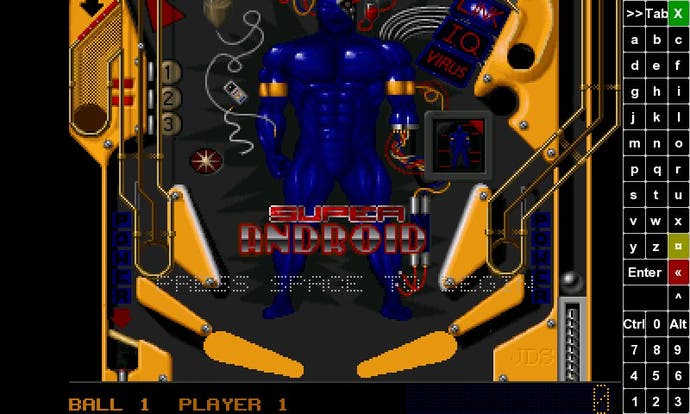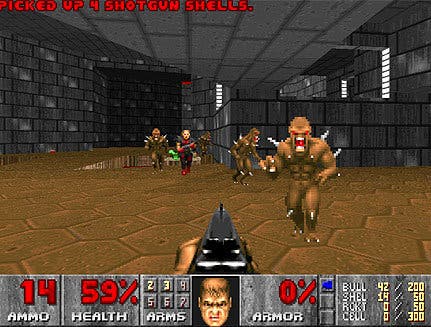The Shareware Age
A brief history of the PC's first reinvention.
Mein Lieben!
While EGA was widely supported and easy to develop for, many shareware programmers harboured ambitions to one day make games that didn't look like sick. As before id Software led the charge with the 1992 release of Wolfenstein 3D (again distributed through Apogee), which used the high end VGA 256-colour mode. (Remarkably, the VGA standard had been introduced way back in 1987, but with games not yet being seen as a legitimate reason to upgrade it had remained expensive and poorly supported.)
In spite of relatively high hardware requirements, Wolfenstein-3D became a huge hit, netting millions of dollars for both id and Apogee (who worked on a 50/50 split and had minimal overheads) - but leading id to realise that they'd outgrown the need for Apogee. They promptly severed their relationship and took their publishing activities in-house.
1992 also marked the arrival of the other main challenger to Apogee's dominance: Epic Megagames. Epic used VGA graphics and sampled sounds across nearly all of their games, explicitly aiming to match the production values found on other formats. They also tapped the talent of the European demoscene with games like Epic Pinball and Solar Winds featuring incredibly slick 2D graphics engines written in assembly language.

(Although Epic have since gone on to become one of the world's most successful developers, their name was originally ironically chosen to make them sound bigger than a couple of guys in a basement. It's hard to imagine Epic, whose output now focuses exclusively on gruff musclemen with huge weapons, ever harbouring feelings of inadequacy.)
It had only taken a few years for shareware games to progress from punctuation marks running around mazes to (what was then) the bleeding edge of 3D graphics. Even the 'Big Three' publishers (Apogee, id and Epic) were struggling with the rising expectations in production values. While some interesting games were released in 1993 (such as Apogee's Halloween Harry, Epic's Xargon and Ken's Labyrinth), development cycles were getting longer and budgets getting bigger. This didn't seem to be an immediate cause for concern, as hits like Wolfenstein-3D, Duke Nukem and Epic Pinball were still raking in cash, and were being introduced to many new PC owners through the proliferation of cheap shareware compilation CDs.
In the final weeks of 1993 shareware reached its apotheosis when id released perhaps the single most important PC game of all time: Doom.
Doom...

It was as if all the ground work that had been done over the past decade had been preparation for this moment. Mainstream hype over "multimedia" and "virtual reality" had started to put high-spec PCs in people's homes. Apogee had provided a spectacularly effective business model. Wolfenstein 3D had given id the reputation, experience and resources to be able to take their time over Doom. And finally the fledgling "Web 0.2? internet provided a community that would put the game at the heart of a thriving ecosystem of user-generated content that persists to this day.
Into this perfect storm id released a game that was not just technically and artistically in a different league to any other shareware game, but was a credible contender for best game ever made. Doom wasn't an incremental upgrade of Wolfenstein. It had palpable atmosphere - a skilled level designer could build tension, excitement and dread (and id's level designers were extremely skilled). Puzzles could actually challenge the player in more imaginative ways than merely having them grope around for fake walls. Doom had immediate appeal to almost anyone with a PC capable of running it and along with its sequel (essentially an expansion pack sold through retail) it shifted millions of copies worldwide. (For more on the cultural impact of Doom and the rest of id's games, I urge you to read David Kushner's Masters of Doom.)

In the wake of Doom's success, the first person shooter (or "Doom clone") became a top priority for many (shareware and commercial) PC developers. Apogee were able to cash in quickly with Rise of The Triad (1994), a project which started life as a sequel to Wolfenstein 3D and was directed by ex-id and future-Ion Storm designer Tom Hall. ROTT was weak beer compared to Doom but introduced a few innovations (such as voice taunts and a wide variety of multiplayer modes). It would be another two years before Apogee convincingly advanced the genre with Duke Nukem 3D (in time for id to shift the goalposts again with Quake).
Epic would eventually join the fray with Unreal (1997), but in the immediate wake of Doom their flagship game was Jazz Jackrabbit, a cartoony platformer heavily influenced by Sonic 2, and which is perhaps most notable today for being a collaboration between Cliff Bleszinski (Lead Designer, Gears of War) and Arjan Brussee (Development Director, Killzone 2). Funny how these things turn out.







